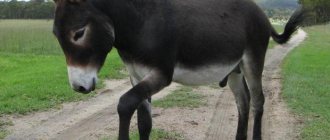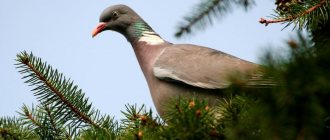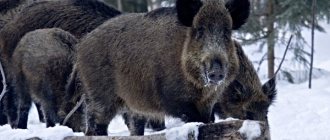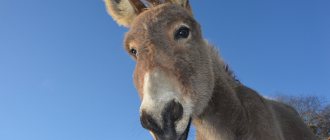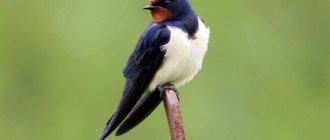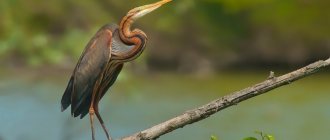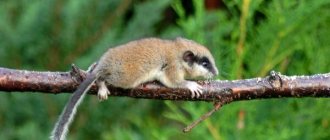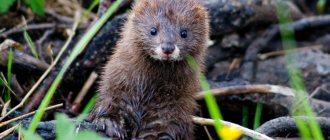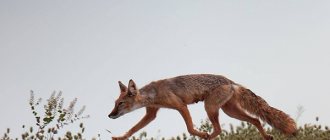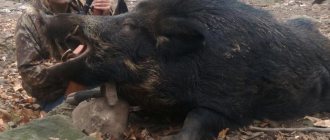Interesting things
Kulan - this is the mysterious name of one of the wild donkeys - a distant descendant of the African donkey. Unlike its ancestor, the Asian wild ass - another name for the wild ass - is considered one of the animals that has never been domesticated, and is one of the few species of the equine family remaining in the wild.
Description of a wild donkey
— Advertising —
The height of a wild donkey is from 90 to 160 cm. Anatomically, it is not very different from a horse. The first has six lumbar vertebrae, while the donkey always has five. The appearance of these animals varies more. The donkey has a larger head, thick, long ears, with long hair on the inside. The body is long, the croup is short. The wool is colored grey, brown or black, sometimes white breeds are found. The belly, the front of the muzzle and the area around the eyes are light. The mane and tail are stiff, the latter is decorated with a tassel. The mane is erect, short, with slightly prominent withers. A narrow dark stripe runs down the center of the back. In some subspecies, stripes may be additionally located on the shoulders (one) and legs (several). The hooves of a wild donkey are black, the heels are high, compressed from the sides. They are narrow and strong, adapted to rocky, uneven mountain paths. Such hooves are not suitable for fast racing, but the animal is still capable of reaching speeds of about 70 km/h.
Appearance and features
Photo: What a donkey looks like
The structure of a wild donkey is similar to that of a horse. Except that he is slightly shorter - 100-150 cm, has five lumbar vertebrae instead of six, his head is larger, and his body temperature is slightly lower. A donkey's coat is usually light gray to black. Rarely, but there are individuals of white color. The muzzle is lighter than the body, as is the belly. There is a tassel at the tip of the tail. The mane is short and erect, the bangs are small, and the ears are long. There are almost always stripes on the legs - by this feature a wild donkey can be distinguished from a domestic one, the latter do not have them.
The hooves of a donkey are noteworthy: their shape is excellent for moving over rough terrain, unlike horses’ hooves, which is why they are used for crossing mountainous terrain. But for a fast and long race, such hooves are much worse suited than those of horses, although donkeys are capable of developing comparable speeds over short distances. Origin from an arid area makes itself felt even in the case of domesticated animals: a humid climate is harmful to the hooves, cracks often appear in them, and due to the introduction of pathogenic organisms there, rotting occurs and the hooves begin to hurt. Therefore, you need to constantly care for them.
Interesting fact: In ancient Egypt, the number of donkeys a person had was used to measure his wealth. Some had a thousand heads! It was donkeys that gave a strong impetus to trade due to their ability to transport heavy loads over long distances.
Feeding characteristics of a wild donkey
Wild donkeys are absolutely unpretentious in nutrition; they can survive for a long time on the meager, low-nutritional food that they find in the desert. Their diet includes bushes of grass and branches of shrubs, even thorny acacias. Compared to other African ungulates, wild donkeys are able to live for a long time without water (they only need to drink once every 3 days), and, for example, zebras, antelopes and buffalos go to water every day. In addition, donkeys can even drink bitter and salty water from desert lakes.
Distribution of wild donkey
— Advertising —
Subspecies of the wild donkey were previously common in northern Africa and Western Asia, but after domestication, which occurred in the era of Ancient Rome, they practically disappeared from these territories. Currently, wild donkeys are found only in Ethiopia, Eritrea, Djibouti, Somalia and Sudan. A small population has taken root in a nature reserve in Israel. In the 1980s, the total number of wild donkeys numbered 1,000, but continued to decline. For example, in Somalia, wild donkeys were completely exterminated during the civil war; the same fate, apparently, awaits the animal in Ethiopia and Sudan. The only country where the wild donkey population remains relatively stable is Eritrea. The number of individuals in it reaches 400.
Unlike originally wild donkeys, feral domestic donkeys are found throughout the world, including in countries where true wild donkeys live. Zoologists fear that this situation will lead to them interbreeding and the “genetic purity” of wild donkeys will be lost.
Up to 1.5 million feral donkeys live on the Australian grasslands. About 6,000 of the animals live in the southwestern United States, where they are called "burros" and are kept under protective custody. The European population of feral donkey is widespread in Cyprus on the Karpas Peninsula. These animals are distinguished by their dark brown or black color, they are also larger than their relatives, and have zebra-like stripes on their legs.
WHY IS IT LISTED IN THE RED BOOK
The wild ass is one of the rarest mammals on Earth.
According to the most optimistic forecasts, about 200 adult representatives of the species remain in the wild. However, scientists believe that the real figure is even lower - 50 individuals. The wild ass was included in the International Red Book in 1986. The number of the species began to decline even earlier - approximately in the early 1970s. And even after they began to take more active measures to protect the species, the situation did not improve. In 1996, the wild ass was transferred from the EN to CR category: over the past 35 years, the species' numbers have declined by almost 95%. Since the beginning of the 2000s. it has disappeared from 50% of its natural habitats. The very first reasons for the decline in numbers are global climate change and the negative impact of humans. Since ancient times, in the traditions of local folk medicine, individual parts of the body of a wild donkey, as well as soup from its bones, were considered a cure for tuberculosis, rheumatism, constipation, lower back pain and some other diseases. Therefore, some animals died in order for a person to be cured.
The lack of sufficient drinking water and food competition from livestock made it extremely difficult for pregnant females and donkeys under three months to survive. Despite the fact that the wild ass is a strong and hardy animal that can go without water for a long time, females and their offspring need more gentle conditions. Another threat to the existence of the species is its crossing with the domestic donkey. Today, programs have been developed and are being implemented to protect these interesting and unique animals.
Common types of wild donkey
Currently, there are two subspecies of wild ass, which are found in Somalia, northern Ethiopia, Eritrea and the Red Sea coast.
Somali wild asses are distinguished by their large body size, dark color and dark stripes on their legs. They live near the coast of the Gulf of Aden.
Nubian wild asses are smaller in size, their color is lighter, and the so-called “dorsal cross” is clearly visible on the back. The subspecies' habitat includes Eritrea, northern Ethiopia and Sudan.
Origin of the species and description
Photo: Donkey
Donkeys are equines. Their ancestors appeared at the beginning of the Paleogene: these are barylambdae and they looked more like dinosaurs than donkeys and horses - a thick animal more than two meters long, it had a short five-toed leg, which still looked a little like a hoof. From them came the Eohippus, forest-dwelling animals the size of a small dog, the number of toes was reduced to four on the front legs and three on the hind legs. They lived in North America, and mesohippus appeared there - they already had three toes on all their legs. In other ways, they also came a little closer to modern equines.
Video: Donkey
All this time, evolution proceeded rather slowly, and a key change occurred in the Miocene, when conditions changed and the ancestors of horses had to switch to feeding on dry vegetation. Then merigippus arose - an animal much taller than its closest ancestors, about 100-120 cm. It also had three fingers, but rested on only one of them - a hoof appeared on it, and the teeth also changed. Then pliohippus appeared - the first one-toed animal from this series. Due to changes in living conditions, they finally moved from forests to open spaces, became larger, and adapted to fast and long running.
Modern equids began to replace them approximately 4.5 million years ago. The first representatives of the genus were striped and had a short head, like a donkey. They were the size of a pony. The donkey was scientifically described by Carl Linnaeus in 1758 and named Equus asinus. It has two subspecies: Somali and Nubian - the former are larger and darker. It is believed that domesticated donkeys originated from crossing representatives of these subspecies.
Wild donkey behavior
The wild donkey is a little-studied animal. He lives in deserts and semi-deserts, in family herds, like zebras. The leader of the family group is an old donkey; it includes up to 10 donkeys and young animals. Herds roam long distances in search of water and food, but always behave extremely carefully.
More common today is the domestic donkey, or donkey, which is descended from a wild donkey. Its color varies from brown, black to white, but gray remains the predominant color. Based on their coat type, they are divided into long-haired, smooth-haired and curly.
Lifestyle
Like zebras, donkeys are kept in family herds (10 mares and young ones) led by a stallion. They roam widely and are very careful. In nature, both smooth-haired and long-haired and curly can be found.
They mate mainly in the spring, less often in early summer. After about 1 year (13-14 months), one or two foals are born and are fed on mother's milk until they are 6 months old.
The donkey becomes very attached to her cubs. The foal reaches independence at almost two years of age.
Reproduction of a wild donkey
Wild donkeys become sexually mature at the age of 2 to 2.5 years. Mating is possible for animals throughout the year, but usually occurs in the spring. At this time, usually calm males become extremely temperamental, and bachelors fight for females with the leaders of family groups. The fights of wild asses are not as violent as those of other equids, horses, kulans or zebras. Usually males bite each other on the neck, legs and rear up. Also, during the mating season, males scream loudly and for a long time without a tune, just like domestic donkeys.
Pregnancy lasts from 12 to 14 months, after which one or two well-developed babies are born, who at 6-9 months begin to lead an independent life. Until this time, milk feeding of the foal continues. At two years old, the foal reaches the size of an adult. Young females become sexually mature at the age of 3 years, and males at 4-5 years.
Donkeys can also interbreed with horses, the resulting mixture being called a mule.
In captivity, wild donkeys have a lifespan of 20 to 25 years.
Life of kulans in the wild
If you think about it, these strange wild inhabitants of Central Asia are very wise - they live sedentary lives, wandering only in case of severe water shortage, although their habitat - deserts and semi-deserts - already cannot boast of even a sufficient amount of it. The herd is headed by an elderly, experienced female, but the real leader is a male, who stays somewhat away from the herd in order to, in case of danger, warn his “subjects” about the danger with a loud roar, clearly distinguishable by the sensitive ears of wild donkeys.
This division of power and responsibilities is perhaps somewhat more logical than that of their natural enemies - wolves.
Among other things, like all mammals living in not very favorable conditions, kulans are very unpretentious in food and water - they can even eat inedible plants and drink salty and bitter water - and are also fast (they develop speed much faster than a horse) and very hardy .
Reproduction among kulans occurs from the last third of spring until the end of summer. During this period, wild donkeys greatly resemble people in their habits - for example, as a sign of sympathy, they lay their heads on each other’s shoulders, biting slightly. Males jump and roll in the dust in front of females, trying to attract their attention, but when another male appears, they immediately engage in battle.
Females carry their young for almost a year, and before giving birth they move away from the herd. From birth, kulan cubs are large, strong and adapted to difficult conditions - after an hour they can follow their mother, although they require frequent feeding and do not follow the female in the first week after birth. The feeding period is approximately ten months, but considering that the onset of sexual maturity in kulans occurs only after three to four years, this is not as long as it seems.
The average life expectancy of wild donkeys is about twenty years, but despite their endurance and adaptability, they suffer greatly from a decrease in their habitat. Now all subspecies of the animal are under protection, some have acquired extinct status. Kulans live in zoos, quickly and easily getting used to people, but leaving not the slightest doubt about the impossibility of their domestication.
Natural enemies of the wild donkey
Wild African asses live in regions with rather extreme climates, so they have practically no natural enemies. Previously, they were hunted by lions, but now the habitats of these animals do not overlap. Nevertheless, the total number of the species is steadily decreasing; wild donkeys have long been included in the Red Book. The reason for this is human activity.
Wild donkeys live in arid areas, every oasis counts there, but the most convenient watering places and relatively abundant pastures are occupied by people, and they push wild animals into practically lifeless regions. Even unpretentious wild donkeys suffer from lack of food and water. At the edges of their natural range, they also mate with domestic donkeys, causing the species as a whole to degenerate.
There are currently up to 500 truly wild donkeys in the world. In order to save the species, the animal began to be bred in zoos. A small group was successfully acclimatized in the Israeli desert. In captivity, wild African asses reproduce well and become tame.
Interesting facts about the wild donkey:
- In ancient times, wild asses were widespread in the deserts of northern Africa. This species is the closest relative of the horse and the ancestor of the domestic donkey. It was domesticated in Egypt around 4500 BC. e. Back then, the domestic donkey was used as a draft animal and a beast of burden. Despite their small stature, donkeys have great strength; they are also well adapted to hot climates and are very hardy. A strong lower back and back allows the donkey to withstand a load weighing up to 2/3 of its weight. For example, a horse can only carry half its weight.
- Two adults can travel long distances on the back of a donkey.
HOW TO FIND OUT
The wild ass is a strong, stocky animal, the body length of which can reach 2 m, and the height at the withers - 1.5 m. The weight of individual, especially large males is 270 kg. The hooves are designed in such a way that it has no difficulty moving over rocky ledges and rocky soil. At the same time, hooves are very sensitive to soil moisture. When kept in captivity, such as in European zoos, hooves can crack in high humidity conditions. Putrefactive bacteria settle in them, and animals often get sick. The entire body is covered with thick short hair, mostly gray in color, only the belly remains light. Sometimes completely white, black or brown individuals are found.
It is the African wild ass that is the ancestor of the domestic donkey. This is the first animal that man began to use to transport goods.
Look at the legs of a wild donkey! Who does this color remind you of? Of course, a zebra. Recently, British scientists discovered the role of zebra stripes. It turns out that this color is the least attractive to horse flies, of which there are simply a huge number in Africa. It is likely that the same evolutionary adaptation is at work in the case of the African ass. A fairly long tail (up to 50 cm) ends with a neat black tassel. The tips of the ears and the tip of the nose are also dark.
